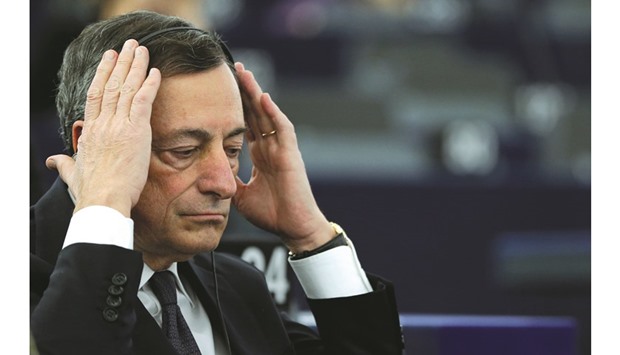It’s an unforgiving world, according to Bank of England governor Mark Carney. Mario Draghi would probably be inclined to agree.
As the European Central Bank president pumps billions of euros of stimulus into the economy every month, he’s seeing continued euro-area expansion and a slow decline in unemployment. But he’s also faces outside forces including an emerging market-led slowdown and an oil-price slump that threaten to drag inflation back below zero.
That’s all combining to make for a gloomy outlook — the European Commission just cut its 2016 forecasts — and means Draghi, who is required to look at price stability, is again reconsidering stimulus mere months after upping his efforts. While data this week will probably show the euro-region economy grew for an 11th quarter at the end of 2015, the pace is modest, and not enough to offset the global disinflationary pressures afflicting the region.
“Domestic demand is OK, it’s the external environment which is not providing that big a boost,” said Marco Valli, chief euro-area economist at UniCredit Bank in Milan. “That is not going to change rapidly anytime soon.”
The 19-nation region probably grew 0.3% in the fourth quarter, according to economists surveyed by Bloomberg. Growth in 2015 is predicted at 1.5%, the best full-year performance since 2011.
Growth of this kind “must be considered normal in the current climate,” said Karsten Junius, chief economist at Bank J Safra Sarasin in Zurich. “The euro area has an inflation problem, not a growth problem.”
Still, maintaining even that limited quarterly pace could be a struggle: economic confidence slipped at the start of the year and a composite Purchasing Managers Index fell to a four-month low in January. The Stoxx 600 Index has fallen 13% this year and the Sentix investor confidence index dropped to the lowest in more than a year in February.
In addition to global restraints, the euro area is contending with domestic issues, including high levels of debt in some countries and the refugee crisis. The ECB wants governments to do more structural reforms to help strengthen the fundamentals of the economy.
Central banks such as the ECB are “expected to do way too much,” Mohamed El-Erian, chief economic adviser at Allianz and a Bloomberg View columnist, said on Bloomberg television on Friday. “Central banks cannot lift the economy on their own and we know that there are lots of costs and risks, collateral damage, of relying just on central banks.”
The European Commission on Thursday cut its 2016 growth prediction to 1.7% from 1.8% and said Germany, France and Italy — the region’s largest economies — will all perform worse than predicted just three months ago. It sees inflation of just 0.5% this year.
Draghi said the same day that there are “forces in the global economy today that are conspiring to hold inflation down.” Carney referred to an “unforgiving global environment and sustained financial-market turbulence.”
For the ECB, which has a price stability mandate, the challenge is to push inflation back up to its goal of just under 2%. While the rate rose to 0.4% in January — the most in since October 2014 — policy makers expect weaker oil prices to drag it lower again in the coming months.
Concerned that inflation expectations could become dislodged, triggering a negative spiral and delayed spending that would cut demand, the ECB’s Governing Council has said it will decide on at its meeting on March 10 whether more needs to be done.
“The eurozone is not immune to financial-market turmoil and weakness elsewhere, with recent numbers proving to be disappointing,” said ING analysts including Mark Cliffe in London.
“At the same time, inflation is likely to be depressed by further declines in energy costs, with the ECB concerned that a prolonged period of negative headline inflation may lead to further drops in inflation expectations.”

Mario Draghi adjusts his earphones as he attends a debate at the European Parliament in Strasbourg, France on February 1. As the ECB president pumps billions of euros of stimulus into the economy every month, he also faces outside forces including an emerging market-led slowdown and an oil-price slump that threaten to drag eurozone inflation back below zero.


